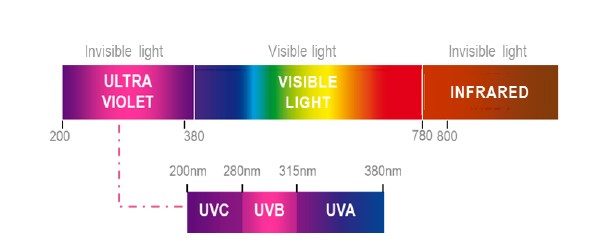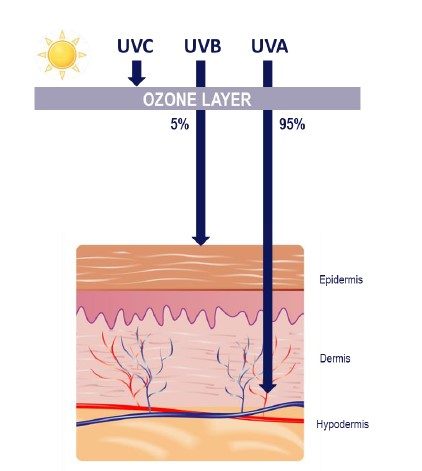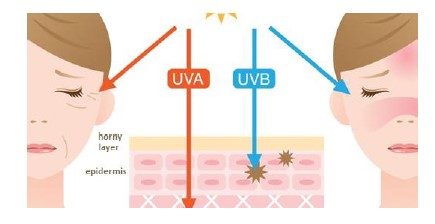The sun is a star located about 150 million kilometres from Earth whose light takes 8 minutes and 18 seconds to arrive here. Without it, there would be no life on Earth; it would be pitch-black and very cold.
The nuclear reaction in the sun’s core creates large amounts of radiation. This energy, also called the electromagnetic spectrum, occurs in the form of radio waves, microwaves, infrared radiation, visible light, ultraviolet rays, X-rays, and gamma radiation.
Depending on the wavelength, these different kinds of solar radiation have different impacts:
The level of ultraviolet rays that reach the Earth’s surface depends on the distance that they travel in the atmosphere. Thus, the shorter the path, the more UVB there will be. This is why the level of ultraviolet radiation that reaches the Earth’s surface depends on a number of factors:


Ultraviolet radiation is invisible and has a wavelength from 200 to 400 nanometres. Its wavelength is shorter than visible light and contains more energy. Depending on the wavelength, it can travel through the ozone layer and has different effects on health. The shorter the wavelength, the more harmful it is; however, it will also have greater difficulty penetrating the skin. Ultraviolet radiation is divided into three bands:


1/ UVC rays
UVC rays have a wavelength from 200 to 280 nm and are the UV rays with the most energy. They are extremely dangerous to all forms of life (even in very weak doses). The percentage of UVC rays reaching the Earth’s surface is minimal: as soon as they arrive in the atmosphere, a photochemical reaction (that requires the presence of light) occurs with the ozone. In this way, 99% of UVC rays are absorbed by the atmosphere, thanks to the ozone layer. The minuscule portion of these UV rays that get through the atmosphere have difficulty penetrating the skin, as they are stopped by the epidermis.
2/ UVB rays
UVB has a wavelength from 280 to 315 nm and is 100 times less common than UVA. A large portion of UVB is absorbed by the ozone layer. Only 2 to 5% of UV rays reach the surface of the Earth, although they remain highly energetic. They primarily penetrate the horny layer of the epidermis. Only 10% reach the dermis.
Impact on the skin:
They are responsible for long-term tanning and sunburn, as well as for most skin cancers.
3/ UVA rays
UVA has a wavelength from 315 to 380 nm. We distinguish between short UVA wavelengths (between 315 and 340 nm) and long UVA wavelengths (between 340 and 380 nm). It is not easily absorbed by the ozone layer, and thus almost 95% of this radiation gets through. It easily penetrates the skin, with about 20% to 30% reaching the medium dermis.
Impact on the skin:
4/ UVA and UVB
UVA and UVB radiation has combined effects and acts synergistically on the skin.


DNA damage: Cellular DNA is the ultimate target of attack for UVB rays. Nucleic acid absorbs UVB radiation, which creates specific bonds. UVA alters DNA via the intermediary of reactive oxygen species that are responsible for chain ruptures, protein-nucleobase crosslinking and oxidative damage to base pairs. These abnormal links then lead to a modification of the DNA’s structure, which alters the normal operation of DNA polymerase, an enzymatic complex that is involved in replication. This consists of the replication of genetic information through the replication of the DNA molecule (a parent strand with a newly synthesized strand). In the long term, if this occurs repeatedly, these abnormal links will overwhelm the DNA repair system. Indeed, these pairing errors are normally detected by enzymes that cut off the short fragment of DNA containing the error and eliminate it. DNA polymerase ensures the synthesis of the missing portion, which repairs the DNA. If these anomalies are not detected, they can lead to potentially carcinogenic cell mutations, such as melanoma or carcinoma.


Sunscreen provide one of the best ways to protect yourself from the sun’s ultraviolet (UV) rays. Australia has one of the highest rates of skin cancer in the world.
Sunscreens contain substances that either absorb or reflect UV rays. They prevent most UV rays from penetrating the skin and damaging skin cells. Many Australians use sunscreens daily. This is why sunscreens need to be regulated in Australia to ensure they are safe, efficacious and of good quality.
Only approved ingredients can be included in sunscreens, and each of these ingredients has been assessed for safety and quality.
Sunscreen products come in many forms including creams and aerosol sprays. The amount of a sunscreen you need to use is explained on the label and when used as intended should provide the appropriate protection.
The TGA requires the efficacy of each sunscreen product to be tested to determine the sun protection factor (SPF). The SPF value for the product is printed on the label.
TGA regulates sunscreens in Australia that are classified as therapeutic goods (therapeutic sunscreens) to make sure they are safe, efficacious and high quality. This means that therapeutic sunscreens need to meet all the legal requirements for therapeutic goods before they can be supplied in Australia. Sunscreens in the Australian Register of Therapeutic Goods (ARTG) are approved for supply in Australia. Most sunscreens in the ARTG are listed (lower risk) medicines.
Therapeutic sunscreens include:
(tga.gov.au)